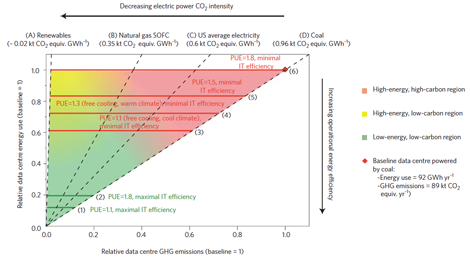Winston Saunders has worked at Intel for nearly two decades and currently leads server and data center efficiency initiatives. Winston is a graduate of UC Berkeley and the University of Washington. You can find him online at “Winston on Energy” on Twitter
 WINSTON SAUNDERS
WINSTON SAUNDERSIntel
A recent article on the carbon footprint of data centers by Eric Masanet, Arman Shehabi, and Jonathan Koomey, published in the online journal Nature Climate Change, gives some very clear signposts to those wanting to optimize the carbon-performance of their data center. The ideas are presented in the article in a terse academic style. But as these ideas have, I think, real business value, I wanted to summarize them in a blog post for a more general audience.
The idea of Nature Climate Change article is to take a step toward a more comprehensive look at the carbon intensity of data centers. As readers here know, a universal metric gauging the carbon intensity of data centers in terms of a "unit of work output per unit of work input" has eluded the industry.
The familiar PUE metric, which promotes infrastructure efficiency, addresses only part of the problem. Ideas proposing server efficiency and proxy studies have looked at various the computational efficiencies of the data center. But a comprehensive look requires understanding the entire data center including network and storage energy use, definitions of useful and non-useful work, as well as some measure of software efficiency capability.
Broadening the Scope
The work of Masanet et. al. takes the valuable step of extending the carbon footprint to the entire data center, including the embedded carbon footprint of not only the servers, but the networking and storage systems.
A key point made is that the embedded carbon of IT infrastructure is much less than the carbon from operational emissions (as based on standard U.S. energy sources). Hence to have a low carbon data center, one must optimize work efficiency. And while PUE is an essential element of that, it is not sufficient.
To make this clearer, the authors introduce a conceptually simple yet powerful way to represent what they call the energy-carbon performance map. I reproduce it (with permission) below to highlight a couple of key points.
Increased IT Efficiency Leads to Improved Energy-Carbon Performance
The first key point is that IT efficiency is the dominant factor in improving the energy-carbon performance of a data center. This is consistent with the findings of the DCUE arguments I made in a blog post on Intel communities, see link above.
The second key point is that improving infrastructure, say as the authors illustrate, from a PUE of 1.8 to an optimal 1.1 only marginally improves the energy-carbon performance.
Thus, if one truly wants to look to optimizing a data center carbon footprint, one should look beyond the infrastructure and look to the IT equipment in the data center itself. The data center is an information factory. To optimize it overall, you need to look at the sum of the parts.
For more information you can read Jon’s informative blog item here, and you can also request a copy of the article. And I’m sure if you have comments or questions Jon or the other authors will address them either personally or thru a reply to a comment below.
Industry Perspectives is a content channel at Data Center Knowledge highlighting thought leadership in the data center arena. See our guidelines and submission process for information on participating. View previously published Industry Perspectives in our Knowledge Library.





